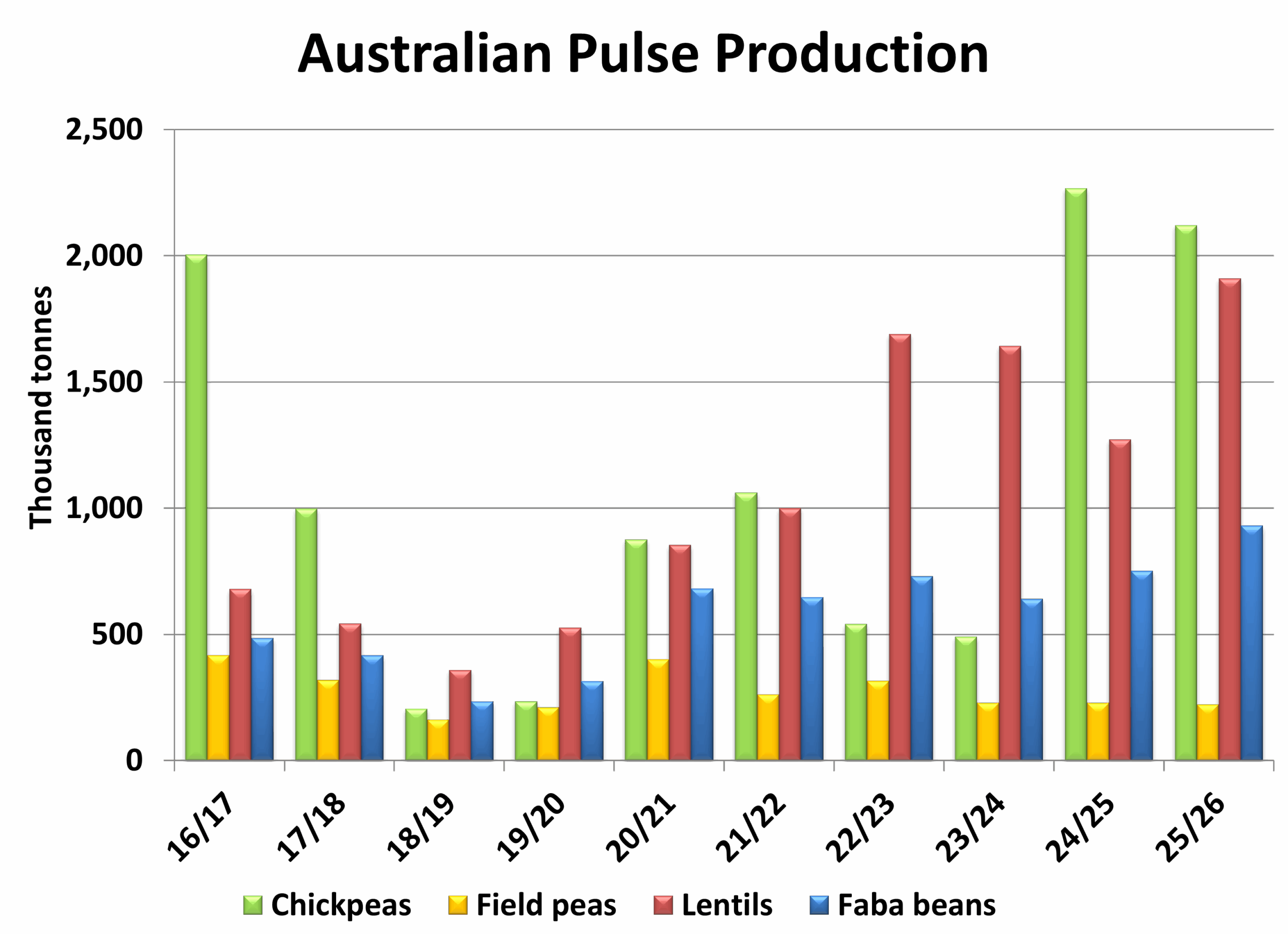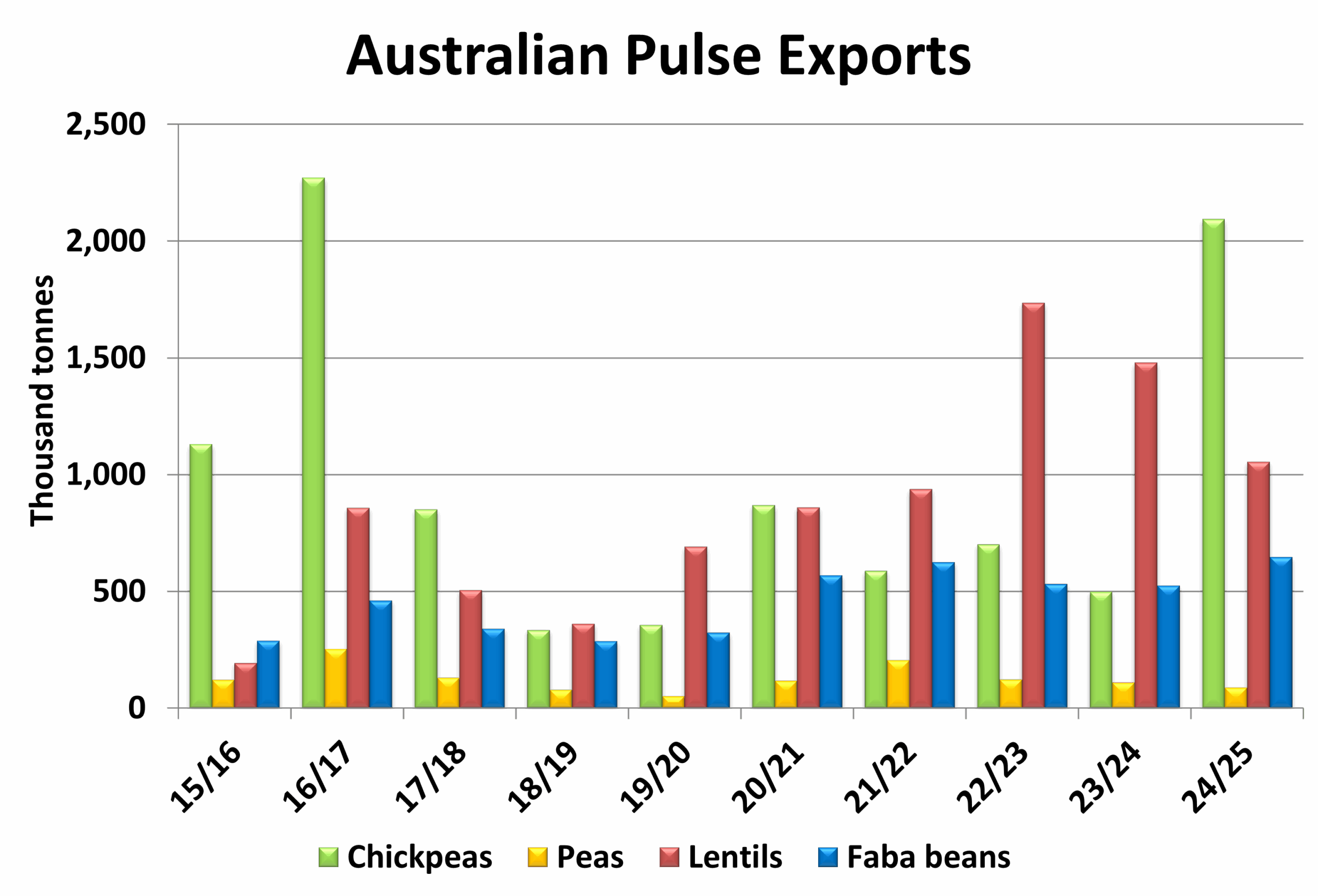By Jon Driedger, LeftField Commodity Research
December 2025
The latest update from the Australian Bureau of Agricultural and Resource Economics and Sciences (ABARES) affirmed that Australia will see record pulse production this season, with essentially all crops seeing upward revisions from the previous September estimate. Growing conditions were mixed during the year in the key pulse-producing regions, including some early dryness, and then wet weather that delayed harvest. However, that did not prevent big yields from being realized, while seeded area was at, or near, record levels for most pulses. The crop is not fully harvested yet, which leaves the potential for adjustments in future updates. And not unlike in Canada, there is a tendency for the government production estimates to be revised higher down the road, which would further add to supplies.

According to ABARES, chickpea production (primarily desis) dipped 7% to 2.1 million tonnes, very similar to the September estimate, although not quite matching last year’s record. Even so, this compares to the five-year average prior to 2024/25 of 640,000 tonnes, reflecting the huge jump in crop size the past two seasons. Seeded area was an all-time high at 1.1 million hectares, which is nearly double the five-year average, while yields dipped to 2 tonnes per hectare (t/ha) from the previous season’s record of 2.2 t/ha.
The huge spike in chickpea production in 2024/25 led to a surge in exports last season, in excess of 2 million tonnes, over four times the size of the previous year. Trade data does not show the breakdown between desi and kabuli chickpeas, although it is estimated that less than 10% of exports are Kabulis. Most of the shipments go to South Asia, with India being the largest destination, particularly early in the marketing year. India’s chickpea inventories are reasonably comfortable, which will make it more difficult to move the large crop, and could mean more desis get directed to other Asian markets. It may also result in shipments being spread somewhat more evenly over the year, rather being as front-loaded as last season.
ABARES showed lentil production increasing by over 50% to a record 1.9 million tonnes, well ahead of the previous record of 1.7 million tonnes in 2022/23. This was also up from the September estimate of 1.7 million tonnes, despite some concerns around wet conditions delaying harvest, particularly in South Australia. The big crop was driven primarily by a 38% increase in yields, to 1.7 t/ha, while area was up 10% to 1.1 million hectares, the seventh consecutive year of higher plantings.
Australia’s lentil exports slipped to 1.1 million tonnes in 2024/25, the lowest in three years, although still far above any season prior to that. Most of the shipments went to India and Bangladesh. Record production this year means exports should be higher in 2025/26, although likely not reaching the 1.7 million tonne record from 2022/23. Most of Australia’s lentil production is reds, which when combined with a bigger Canadian crop will keep supply pressure on global markets. At the same time, this has largely been factored in by traders, and there are signs lower prices may be encouraging additional demand, which would help to work down supplies.
Faba bean production came in at 930,000 tonnes, up 24% from last season, which itself was a record, and well above the September estimate of 854,000 tonnes. This was driven by a 10% increase in plantings, to an all-time high of 441,000 hectares, while yields were also up at 2.1 t/ha, not a record but still historically large.
Most of Australia’s faba beans are exported, with record shipments of 646,000 tonnes in 2024/25. Movement could exceed that figure this season given the larger supplies, which will keep pressure on global markets. Egypt will likely take most of the volume, with smaller amounts going to other Middle Eastern countries.
Peas are one of the smallest pulse crops in Australia, with ABARES pegging production at 221,000 tonnes, the lowest since 2019/20 due to the smallest plantings in over 30 years, although down only modestly from the previous two seasons. Exports were below 100,000 tonnes in 2024/25, despite China’s import tariffs on Canadian supplies, which suggests Australian exports are likely to be low again this season.

As much as a large Australian pulse harvest increases competition for Canada in global markets, at the same time crops were also bigger in some other competing exporting countries, the latest figures were not a surprise and already factored into values. Even so, it also ensures comfortable supplies through the remainder of the marketing year, which could limit upside price potential until attention starts to shift to 2026 production.
Jonathan Driedger is Vice President with LeftField Commodity Research. He can be reached at jon@leftfieldcr.com.